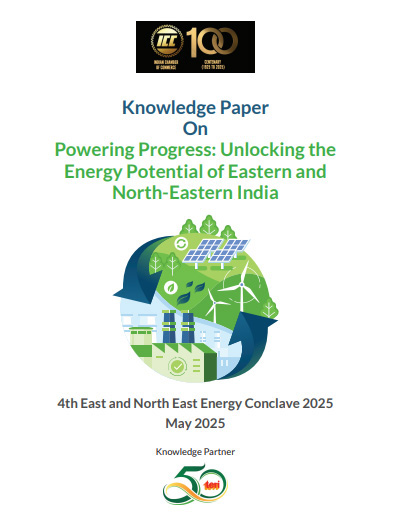Knowledge Paper On Powering Progress: Unlocking the Energy Potential of Eastern and North-Eastern India
Twelve Eastern and North-Eastern states together own barely 9 per cent of India’s installed generation capacity—about 42 GW, of which only 10 GW is renewable. Yet official resource potential show an extraordinary ≈218 GW of technically exploitable solar, wind, small-hydro and biomass potential, including ~50 GW of large-hydro potential in the Himalayan rivers. Bridging that gap is critical for meeting India’s 500 GW non-fossil target by 2030 and its net-zero pledge for 2070.
ABOUT THE PAPER
Commissioned by the Indian Chamber of Commerce and authored by TERI, the Knowledge Paper offers the first integrated roadmap for a clean-energy surge in Eastern and North-Eastern India. It combines:
- State-wise resource mapping (MNRE & CEA data)
- A three-phase action plan spanning 2025-30 (Foundation), 2031-40 (Scale & Innovate) and 2041-47 (Consolidate).
The analysis is anchored in various policy levers—RDSS, the Green Hydrogen Mission, the BESS Viability-Gap Fund—highlighting how these policies can be effectively implemented.
KEY INSIGHTS
- Storage as lynchpin – Fast track PSP projects to balance solar and wind and explore opportunities in the mine-void sites/abandoned mines as closed loop PSPs, the regions can develope extensive number of small hydro pumped hydro storage plants in down streams of existing hydropower; potential to deliver a quarter of India’s PSP need by 2032, while early BESS pilots pave the way for grid-scale batteries.
- Hydrogen & industry – Steel, fertiliser and refinery clusters in Odisha, Jharkhand and Assam are ideal launch-pads for green-hydrogen valleys, leveraging co-located renewables and port infrastructure.
- Smart-grid leapfrog – Assam and Bihar’s rapid smart-meter roll-outs demonstrate how digitalisation can cut AT&C losses and unlock demand response for renewables.
- Inclusive electrification – Solar micro-grids, rooftop PV and solar pumps remain essential for the last-mile hamlets in Arunachal and Nagaland, linking energy access with livelihoods.
PATH FORWARD
- State-specific RE roadmaps with clear 2030 and 2047 milestones and streamlined single-window clearances.
- East-NE Clean-Power Corridor to pool hydro, solar and storage across state borders and into the National Grid.
- Public–private platforms to co-finance pumped-storage, and hydrogen hubs, using green bonds and blended-finance facilities.
- Community-centered just-transition compacts that repurpose de-coal mines for clean power and retrain the workforce.
- Establish an East & North-East Energy Transition Council for coordinated development, sharing of best practices, and resolving inter-state issues.
- Deploy grid-scale BESS in urban centres and solar parks; support community-level storage in remote areas.
Implemented decisively, these measures can deliver reliable, affordable, low-carbon power to every citizen of Eastern and North-Eastern India—turning a latent resource base into a powerhouse of India’s clean-energy century.

